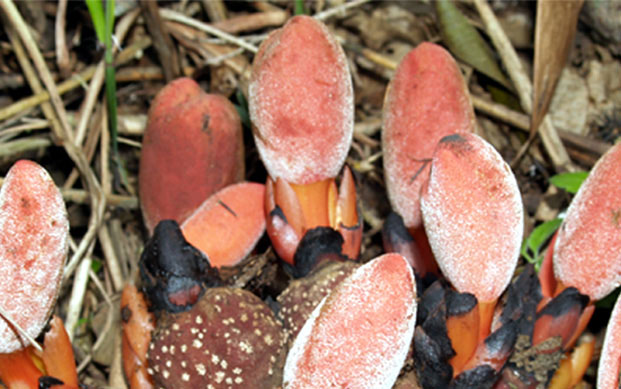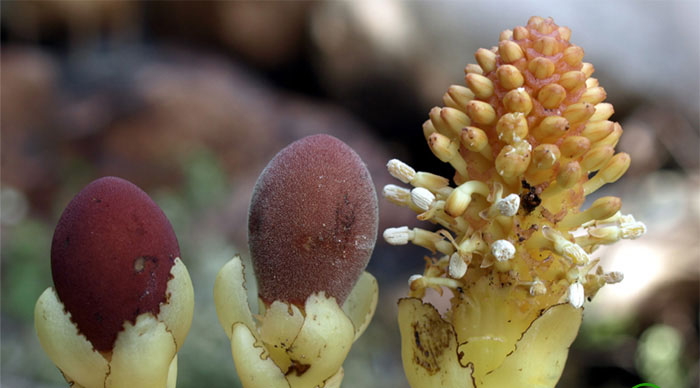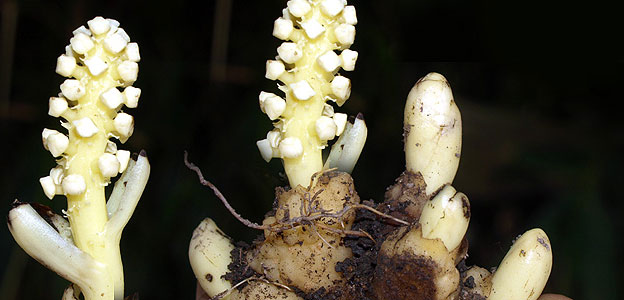Those who are not chlorophyll live in Vietnam
In nature in Vietnam, there are some plants that do not have chlorophyll on their bodies, they live on the nutrients from the decomposing organic substances of other organisms, or from dead tissue.

Most plants live in high mountains, and are precious medicinal species in the folklore. However, the number of species is very rare for even plant researchers. Some species have been included in the Vietnam Red Book.
On the picture is the flowering tree , Balanophora laxiflora . At the top of Mau Son - Cao Bang, 1,600m above sea level, Balanophora laxiflora is included in the Vietnam Red Book, blooming in the late cold and as the signaling the northeast monsoon winds will overflow. about.
Parasitic plants on roots, reddish brown, no chlorophyll, 10 - 20cm high. This tree is a rare and very unique genetic resource, it is also used as medicine. They are now actively hunted species to serve the vitality-enhancing remedy for gentlemen.

It is Balanophora fungosa soil . In the plants of the Balanophoraceae family, the Balanopphora fungosa has a wide distribution range from India, Indochina to Hainan Island, Peninsular Malaysia, Sumatra Island (Indonesia), and several islands in the Pacific Ocean. and Australia.
In Vietnam, many people meet them in the area from Hanoi to An Giang. This is a common species growing in evergreen forest. They flower all year round but mostly from November to April next year. This species lives parasitic on the roots of woody plants, both trees and vines.
Ethnic minorities in Ninh Thuan often use sharp water to make medicine to treat abdominal pain and body pain. Some people use it as a sunflower as a medicine to soak wine, strengthen the tendon.

There is a wide area of Balanophora latisepala . Minh Dam mountain range in Ba Ria-Vung Tau with a great variety of species exists, is now only in memory for people living around this mountain. Now they are all alone with the silvery mother stones of the year and the surrounding bushes.
Although the devastation of human beings wanted to exterminate the creatures that have been created for the nature here, somewhere in the deep, interstitial caves of the species, there is still a wide area of Balanophora latisepala. developed in wet, underexposed cliffs.
The parasitic plant is not stemmed, has hard roots, wrinkled face, and star-shaped acne. Their female flowers are round, reddish brown, short stalks.

Chrysanthemum soil Balanophora cucphuongensis . This is a narrow endemic species of northern Vietnam, the first time this species was discovered by researchers Nguyen Tien Ban in the Bong area of Cuc Phuong national park, Ninh Binh province in 1995. Currently this species is introduced. Vietnam Red Book.

The head of the Rhopalocnemis phalloides . In parasitic plants, this plant really brings a delight to the admirer. The parasite species on this root has absolutely no leaves and no chlorophyll, it is 15 - 25cm tall. Body fat, tuberous, dark yellow or brownish yellow.
This species is included in the Vietnam Red Book, because it is a rare genetic resource, the only representative of the single species Rhopalocnemis in Vietnam. This species was discovered by researchers to be scattered in the forest (parasitic on the roots), broad-leaved trees, at an altitude of about 1,000 - 2,000m in Kontum, Lam Dong, Gia Lai.
- Detection of organisms containing chlorophyll but not photosynthesis
- Sea slug: Calling is a child or a tree?
- Found a rare form of chlorophyll in a new bacterium that is sequenced
- This bacterium will be the world's new energy source
- What if our bodies can synthesize food like plants?
- Why are leaves green?
- Why when watching live football, have a fast TV, have a slow TV?
- Launching the Vietnam Robocon Contest 2007
- Son Doong Cave is a live broadcast of American television
- Vietnam and Asia have a meeting to save wetlands
- Supercomputers beat people coming to Vietnam
- Sarus cranes leave Vietnam to Cambodia
 Why do potatoes have eyes?
Why do potatoes have eyes? 'Tragedy' the world's largest carnivorous life: Death becomes ... public toilet
'Tragedy' the world's largest carnivorous life: Death becomes ... public toilet Tomatoes were once considered 'poisonous' for 200 years
Tomatoes were once considered 'poisonous' for 200 years Detecting microscopic parasites on human face
Detecting microscopic parasites on human face Strange species in Southeast Asia becomes the first marine fish species 'extinct due to humans'
Strange species in Southeast Asia becomes the first marine fish species 'extinct due to humans'  Ancient humans may still live on Indonesia's Flores island
Ancient humans may still live on Indonesia's Flores island  The 'dragon' species that was thought to only exist in myths is one of the rarest on the planet.
The 'dragon' species that was thought to only exist in myths is one of the rarest on the planet.  How many animals have ever existed on Earth?
How many animals have ever existed on Earth?  Treasure of Southeast Asia: Rare animal species found in only 9 countries in the world, Vietnam just received good news!
Treasure of Southeast Asia: Rare animal species found in only 9 countries in the world, Vietnam just received good news!  'Ghost humans' discovered leaving 'hybrid offspring' in 3 modern countries
'Ghost humans' discovered leaving 'hybrid offspring' in 3 modern countries 